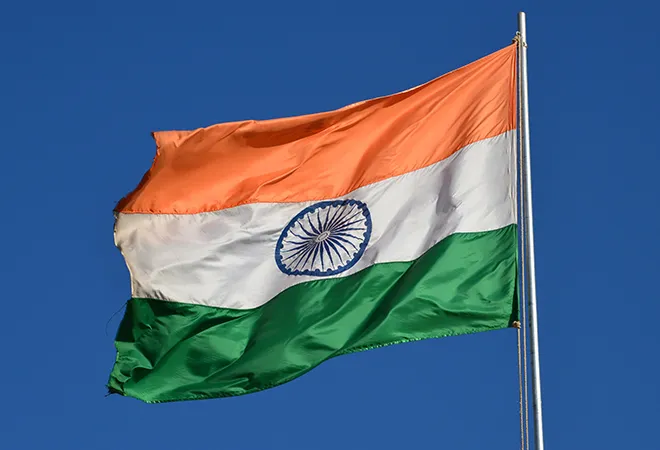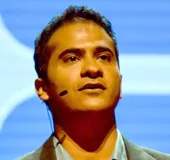-
CENTRES
Progammes & Centres
Location

India turned another year older yesterday. Independence Day akin to birthdays and anniversaries, commemorates a significant occasion, but time is a fickle friend. For years later, the origin of these occasions gets inadvertently diluted, while the festooned celebrations continue with pomp and grandiosity.
These memorable dates are juxtaposed by assessing the bright possibilities that lay ahead, while also nostalgically revisiting the past.
In Michael Wood’s epic The Story of India, the opening stanza includes words such as “the brief heyday of the West draws to a close, one of history’s greatest players is now rising once again”.
As India rushes headlong into the future, the talk has been on India now emerging as a leading player in the complicated realm of geoeconomic and geopolitics.
This has been chronicled in Alyssa Ayres book Our Time Has Come – How India is making its Place in the World.
The book is very much apropos to a time when the global economic forces have made a tectonic shift eastwards. As the dragon breathes fire (China’s meteoric rise), the elephant is said to not be too far behind – albeit some distance away but meandering faster than usual. India is now said to be the sixth largest economy in the world having dislodged France and just a spot away from its former colonial masters – the United Kingdom. India’s ever-expanding defense budget compliments its large defense forces. It is the second largest populous country in the world and one that is set to surpass China soon. A robust talent pool, a burgeoning young workforce with estimates of 70 percent said to be under the age of thirty. The signs for the future look ominous for now, but as Member of Parliament, author and historian, Shashi Tharoor, so well-articulated in this seminal talk, that this is not what India’s actually about.
While economists forecast and remain sanguine about India’s future, it’s historians who revel in its cultural dynamism and its eclectic mix of religion and language.
In fact, it was the late former Prime Minister of Singapore, Lee Kuan Yew who once said in order to understand your present success, you need to first look to understand your past.
Incidentally Mr. Lee speaking sometime in 2012 was accosted by a member of the Indian Administrative Services (IAS) that could he do India, what he had done to Singapore – in the sense create an economic miracle out of the morass?
Mr. Lee’s patiently listened, and his answer not only reflected his sagacity but also his perspicacity of understanding the complexity of India. He remarked India speaks many different languages and has many different dialects. He stated that there was nothing in common between the history and origin of the languages of Tamil and Telegu with Punjabi. Mr. Lee added to the India-China comparison by saying that the leader in China when he speaks in Beijing, can be understood by 90 percent of the country which are Han Chinese. But no Prime Minister in New Delhi can speak in one language and be understood by the entire nation. Hence, he concluded to a very facile question, that India was a far more complex country to govern than China.
Mr. Lee’s prognosis was that India was a creation of the British Raj and the railway system it built, linking various princely provinces that felt under the dominion.
Therefore, its limitations were far greater to understand than any reductionist homily.
Growing up in a chaotic democracy like India, we exercised free speech often enough to complain that nothing ever worked. In one of many furors to my dad about the economic malaise and government inefficiency; my dad instead of giving in to my chagrin, asked me “what do you think keeps India unite”?
He elaborated that if you think about it, India has had every problem known to most nation states. Multiple political corruption scandals would take place, but India goes on. A flood, a tsunami, an earthquake would shatter homes, but India found the resilience to go on. India has had and still has rampant poverty, malnutrition and crime, but India would still go on.
His question was bigger and far more philosophical than I could fathom. Given that India has had every major socio-economic and political hindrance, and further accentuated because of its size, what still makes India a functioning democracy? Why hasn’t India disintegrated the same way that the former USSR did, or the way Yugoslavia disintegrated into various Balkan states, or even split like Czechoslovakia for that matter?
My curiosity to this question led me to stumble upon this riveting talk by India’s most well-known historian Ramachandra Guha. The title was how India was the most interesting country in the world. Hyperbolic titles aside, Guha raised a fascinating point of how India was the least likely country and the least likely democracy.
Guha expounded that the history of the nation state in modern world was defined by states where people agreed on the same language, the same religion and agreed to a common enemy. Great Britain defined through a Protestant lens, English speaking country (hence went away the dialects of Gaelic and Scottish) and the French were the enemy. Meanwhile, in France, it was the reverse. The British were the enemy; hence the French were Catholic and a rallying cry around a single language – French.
Guha brilliantly surmises that by the definition of nationhood, Pakistan fits the bill. It was born out of paranoia by certain Indian Muslims in British India. The country fell under a single religion of Islam, Urdu was imposed on Punjabi, Sindhi and Bengali speakers and the archaic definition of Pakistani was based on an anti-India or not-Indian sentiment.
In other words, if partition created a Muslim Pakistan, then the logical conclusion was that it would create a Hindu India.
However, as Manish Tewari writes “out of a bloodstained Partition there emerged two ideas of nationhood – a progressive, pluralistic and inclusive impulse that became the idea of the Republic of India and a theocratic template that became the idea of the Islamic Republic of Pakistan”.
By contrast, India is said to be epitome of a place that finds ‘unity in diversity’.
The country does not have a single national language, instead it has 22 indigenous languages (with over 700 dialects) with each officially recognized as the various national languages of India by the constitution. The birthplace of religions such as Hinduism, Buddhism, Sikhism, Jainism adds to India’s cultural smorgasbord. Even the Abrahamic religions have a unique history in India. Publicly, India has been the one country where members of the Jewish diaspora (who arrived as early as the first century) have never faced any form of state led persecution. India is the second largest Muslim nation in the world, despite not being an Islamic country, and has more Christians than Australia’s entire population.
But statistics don’t accentuate diversity, stories do. And in the General Elections of 2004, the majority of votes were secured by the Congress party. What was fascinating then, was that the party head was Sonia Gandhi, a woman of Italian origin and Roman Catholic faith, who made way for a Sikh Prime Minister – Dr. Manmohan Singh, to be sworn in by a Muslim President, Dr. APJ Abdul Kalam in a country where 80 percent of its population identify as Hindu. As Shashi Tharoor said, this wasn’t a case of India proving anything to the world, it was a case of India just being itself.
As India goes to the polls next year, it will once again be the largest voting exercise in the democratic world. At the time of independence in 1947, many prophesized that it would be hard for India to survive as a nation given the fissiparous nature of the many states and the destitute state that the British had left behind. The squalid thug, Winston Churchill once said that “India is a geographical term. It is no more a united nation than the equator”, almost defying the idea of India’s existence.
Yet unlike many of the other colonies that became tin-pot dictatorships, India adopted a thriving democracy as early as 1951, by implementing universal suffrage. Guha, the historian waxes lyrical on how the first elections in independent India in 1951 were seminal since 65 percent of its population were largely illiterate. Even Switzerland, the bastion of western utopia adopted universal suffrage as late as 1971.
Despite having many dysfunctional bureaucratic institutions, no one has questioned the legitimacy of the Election Commission in holding free and fair elections across the country. Even the oldest and most robust democracy, the United States has had its Supreme Court intervene in the vital 2000 elections between Bush vs Gore, courtesy the Florida kerfuffle.
So how is it that a nation with no one language, no one religion, no one ethnicity, plagued by all the woes indigenous to emerging economies, can actually survive and yet thrive as a chaotic fractious and simultaneously as a robust democracy? Perhaps, it’s no wonder that The Economist dubbed India’s diversity closer to a continent (like Europe) than to a country. After all each state in India is as different as Liechtenstein is from Italy or Sweden from Wales or Spain from Ukraine.
I personally don’t think there is a single answer for what invisible string holds India’s eclectic enchanted pearls of religion, language, culture and ethnicity together. Ergo Guha, profoundly stated that “India is the most recklessly ambitious as well as ambitiously reckless political experiment in human history”.
Many historians before him have tried to answer what keeps India united, but many have come up short. Some have even put forward anodyne and inane theories of saying the feverish sport of cricket and the larger-than-life imagery of Bollywood is what unites an eclectic mix of a billion people.
In reality, neither of these theories hold much water. Facile theories don’t suffice for complicated questions. India, truly exists and thrives as a one-of-a-kind democracy that finds unity in extreme diversity.
But I can’t leave the readers hanging, and hence I think the best answer has come from another historian – Shashi Tharoor when he says “India is the nationalism of an idea. An idea of an ever, ever land emerging from an ancient civilization, united by a shared history but sustained above all by a pluralistic democracy”
The views expressed above belong to the author(s). ORF research and analyses now available on Telegram! Click here to access our curated content — blogs, longforms and interviews.

Akshobh Giridharadas was a Visiting Fellow based out of Washington DC. A journalist by profession Akshobh Giridharadas was based out of Singapore as a reporter ...
Read More +